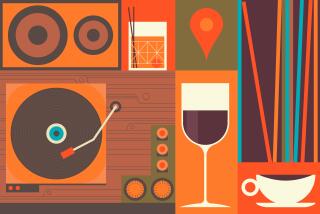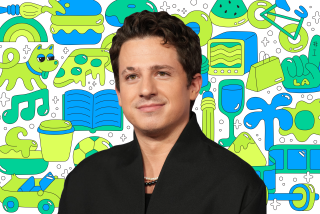Israeli Cities Have Bright Night Life
TEL AVIV — For most visitors the words holy, historical, archeological and ancient are used to describe this land on the eastern shore of the Mediterranean.
Rarely would one consider describing the life of its people and the pulse of its cities as thriving or bustling. Yet Israel, a country filled with a paradoxical blend of peoples, is also the setting for a paradoxical night life in its three major cities.
According to its denizens, Tel Aviv is a “Mediterranean New York.” The heartland of Israel’s artistic community keeps its new restaurants, pubs, cafes and nightclubs open until 3 or 4 in the morning on any given weekend night. Thursday night is particularly popular with the theater, opera and music people who live in the district.
Miri Paz, a theater critic for Davar, the Labor newspaper, stays out late most nights of the week to view openings, attend theater parties and stroll on the beach.
“There is usually some new show or exhibit opening to attend,” she said. “I feel very safe going anywhere in Tel Aviv by myself at night since there is very little street crime here or in Israel’s other major cities.”
Three years ago the city built a beige and brown stone walkway along the shore between the major hotel district and Hayarkon Street. Chairs were provided for people to gaze at the sea or watch the parade of people strolling by. The Tayelet (Boardwalk) was an instant hit. At 1 a.m. on a typical Thursday, Friday or Saturday night, one is hard pressed to find an empty seat on it or at an adjacent cafe.
One of those cafes, the Avatichim (Watermelons), is famous throughout the country for the huge wedges of ripe, red watermelon with triangles of feta cheese that it has made into a popular new all-night delicacy. Patrons include some of Israel’s most famous actors, actresses, directors, musicians and some well-known underworld figures.
Moving farther south on the Tayelet, one reaches the busy Bograhof, a cafe on the beach. Its tables and chairs extend far onto the sandy shore. There you can drink Mediterranean or American coffee, Guinness Stout or Macabee Biera and listen to live entertainment. Lively singers and musicians keep the audiences interested, while the sea’s waves add a varying rhythm to the music.
Lining the opposite side of the road are several open-air cafes such as Galgallim (Wheels) and Balloons, adorned with neon facades and populated by Israel’s younger generation.
Dizengoff Street, the shopping and restaurant center a few blocks east of the Tayelet, is packed with Israelis on Friday night and offers the visitor a scene reminiscent of Times Square on New Year’s Eve. One gets the impression that most Israelis celebrate the Sabbath by meeting and greeting at the ice cream stores, blintz shops, cinemas and coffeehouses that line this major thoroughfare.
The street is closed to traffic on the Sabbath, but that doesn’t stop younger Israelis, out in full force on that night, from dancing, “shmoozing” and enjoying themselves. At 3 or 4 a.m. you can buy hot french fries at the MacDavid’s dispensing machine on Frishman Street at Dizengoff.
But Tel Aviv is no longer the only city in Israel that boasts late-night attractions. Haifa, farther north on the Mediterranean, has always been the “working man’s city.” Many Israelis recite a maxim referring to the three major cities of Israel: “Tel Aviv plays, Jerusalem prays and Haifa pays.” It appears that Haifa is paying for, and getting, a good time.
A visitor to this triple-terraced city can choose from many dining places. Humpty Dumpty, a fast-food cafe near the new Dan Panorama Hotel, serves ice cream, blintzes and coffee. The Rondo at the Dan Carmel serves elegant Middle Eastern and continental entrees in an exquisite setting that offers a panoramic view of Haifa to each diner.
HaSefinah (the Boat) is a 500-seat restaurant/disco/cafe constructed from the hull of a boat. Moshe Sagiv, the manager, says that HaSefinah was the result of three men’s holdings and dreams: “One had a boat, one could build an island and one could manage a restaurant.”
Dine, Dance and Dream
They built their small island in the waters of Bat Galim (Daughter of the Waves) on the Mediterranean. Diners enjoy simple salads or drinks while listening to the waves lap against the boat, or they may enter the vessel and join in the disco dancing.
One can get to HaSefinah by taking the newest tourist attraction in Haifa, the Swiss-designed cable-car system on Mt. Carmel. Riding from the heights of the mount near the Carmelite Nunnery over Elijah’s Cave, the visitor gets a magnificent view of the city and the sea. The Piano Bar, in the base of the cable-car system, offers the over-35 crowd a chance to listen to live music while sipping sherry or wine.
HaShemurah (the Preserve) on Derech Pica 38 in Haifa’s Ahuza section is unreachable from the main road; you must park your car on a side street, cross a gravel-strewn walkway and climb through what looks like a sparsely planted forest before coming upon the first layer of tables and chairs in this 250-seat cafe.
There, under the trees, you can treat yourself to a milkshake (spiked or natural), salads, Mediterranean delights or just have a beer or coffee.
Responding to a need expressed by the regular visits of the U.S. Sixth Fleet as well as to the new trends of Haifa’s younger population, 15 restaurants have recently opened in the city, all with hours that extend into the next morning. And there’s been a rise in the popularity of South Beach, where people windsurf and swim during the day and sleep on the beach overnight. Its restaurant never closes; it’s ready with breakfast in the morning.
Haifa is an excellent choice for travelers who want to see the beauties of Mt. Carmel, Caesarea, the Sea of Galilee or the Golan Heights during the day but also want to be well entertained at night.
Just as Haifa has broken its stereotype of a sleepy city, Jerusalem is no longer a city filled only with Anshei HaBayit, people of the house.
Unquestionably, this breathtaking city of mixed cultures and religions attracts some of the most observant worshipers of each group. Yet it also has a vital population of people who find it necessary to get out in the evening and do a bit more than breathe Jerusalem’s clean mountain air.
On any given night a visitor can stroll along Ben Yehuda Street, which is closed to traffic, and find a host of shops and cafes open late and jewelry vendors and flute sellers hawking their wares. During summer the street becomes a fair as magicians, mimes and musicians wander along the cobblestone pavement.
Visitors can watch the show from a free chair provided by the Atara (Crown) or any of the other coffeehouses that line the street, sip a drink and strike up conversations with students, visiting soldiers and Jerusalemites, and feel very much a part of the scene.
Elegant dining in Jerusalem is equally varied and available. One choice is the beautifully designed Grill at the Laromme Jerusalem Hotel on Jabotinsky Street. Its kosher pate de foie gras would have no trouble winning French cuisine awards.
High-quality food and service is also available at the Grill of the King David Hotel, another kosher restaurant on King David Street. The topper for the evening comes at the conclusion of the meal, when patrons are handed little gold paper boxes containing exquisite chocolate mints with hazelnuts.
Less continental but not to be missed is the colorful Arab restaurant, Philadelphia, on Azzahara Street. Its name derives from the ancient Hellenistic name of Amman, Jordan, not the more familiar City of Brotherly Love.
There you will feel the brotherly love of the owners when they bring you a mountain of baklava for dessert--in three varieties--of which you can eat as much as you like. The sweet treats are absolutely irresistible.
Off to the Show
If the cafe or restaurant scene is not your style, try to get to the Sound and Light Show at Jaffa Gate near David’s Citadel in the Old City. The show runs from May to September when the warm weather is soothing to the mind and senses. All seats are built into an archeological garden so that remnants of many past ages surround the viewer.
Contemporary composer Noam Sharif created the music; laser technology creates the light show. It is truly a well-designed spectacle that takes you through the ages of this city’s history.
For some, Israel will always remain noteworthy for its history, kept alive in its myriad archeological and historic sites. To those who seek the pleasure of a fine evening’s entertainment, Israel’s triangle of cities offers a host of exciting night spots that invite all visitors to burn the midnight oil.
More to Read
Sign up for The Wild
We’ll help you find the best places to hike, bike and run, as well as the perfect silent spots for meditation and yoga.
You may occasionally receive promotional content from the Los Angeles Times.






